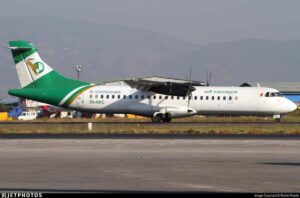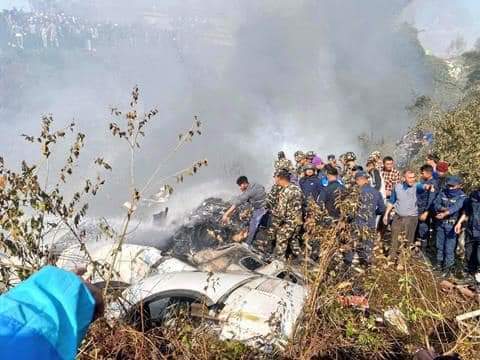Suresh Acharya
Its very sad to learn that the Yeti Airlines 9N ANC ATR-72 carrying 68 passengers and 4 crew members crashes today at NST 10:51 AM during the final stage of landing in Pokhara airport. The aircraft took off from Kathmandu airport at 10:25 AM as per media reporting.
This is the first air crash 15 days after the opening of the newest Pokhara Regional International Airport on 1st January 2023.
The ATR 72 is a twin-engine turboprop, short-haul regional airliner developed and produced in France and Italy by aircraft manufacturer ATR (French: Avions de transport régional or Italian: Aerei da Trasporto Regionale), a joint venture formed by French aerospace company Aérospatiale (now Airbus) and Italian aviation conglomerate Aeritalia (now Leonardo S.p.A.).

ATR-72 series is powered by a pair of Pratt & Whitney Canada PW100 turboprop engines. There are 5 series of ATR 72 and 13 variants.
In the majority of configurations, passengers board the ATR 72 using the rear door, a relatively unusual configuration for a passenger aircraft, while the front door is typically used for the loading and unloading of cargo. While passengers are boarding or disembarking the aircraft, a tail stand is set into place as standard procedure to guard against the aircraft nose lifting off the ground.
ATR 72 started its first maiden commercial flight in 27th October 1989 by FinAir. The ATR 72 has been involved in 46 aviation accidents and incidents since 1994 including 29 hull losses (catastrophically damages the aircraft beyond economical repair) resulting in 398 fatalities, including today’s aircrash in Pokhara.
Yeti aIr crash: several questions!

Today’s incident has raised several questions about the crash of the ill-fated ATR-72. The possible causes of the crash will be known only after the investigation. Generally, following conditions are assumed for the crash.
1) Mechanical fault of the aircraft,
2) Calibration of the new airport,
3) Technical error,
4) Weather condition
5) Human error
This type of ATR aircraft employs carbonfibres for 30% of the wing by weight, for a 20% weight reduction. This may be the reason behind the tilting (upside down) of air-borne aircraft. The eye witness has claimed that the ill-fated aircraft was upside down at an low altitude immediate before the crash.
The Air Traffic controller in Pokhara indicated according to media that the ill-fated aircraft had unexpected drop (free fall or technicallly means stalled) from the sky just before the incident.
There has been construction problem of the new airport due to a hillock at the eastern side of the approach, hence before the calibration flight around 7 acres height of the two hills at Ritthepani 1.5 KM away from the airport border, was reduced by 40 meters.

As eye witness accounted, a fire sparks were seen during the ill-fated flight at the final approache, that indicates a serious technical problem. However, as reported in media, there was no MAY DAY indications from the commanding pilot to the tower about any problems.
Today’s weather condition was fine, thus the weather has been ruled out for the fatality.
The Hindustantimes.com has revealed that Flight tracking website FlightRadar24 said the Yeti Airlines aircraft was 15 years old and equipped with an old transponder with unreliable data.
Above indications point to a mechanical and technical failure for the cause of the crash possibly grounding of all ATR-72 aircrafts engaged globally in commercial flights by the joint French and Italian manufacturer.

Government of Nepal has formed a 5-member committee for the investigation and the cabinet meeting as declared a public holiday tomorrow as a mourning. However, the GoN has not grounded the ATR-72 aircraft operated in Nepal, at least until the investigation report comes out.




